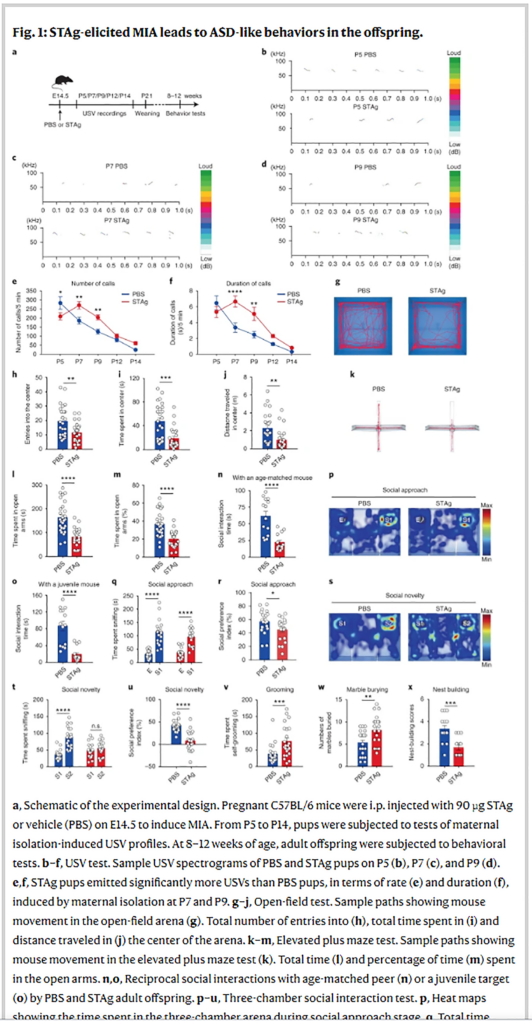Nature Neuroscience Published: 15 April 2021
Rescue of maternal immune activation-induced behavioral abnormalities in adult mouse offspring by pathogen-activated maternal Treg cells (病原体活性化母体Treg細胞を用いた仔マウスの母体免疫活性化誘発行動異常の救済)
Zhipeng Xu, Xiaoyun Zhang, Hao Chang, Yue Kong, Yangyue Ni, Ran Liu, Xiaolin Zhang, Yang Hu, Zhi Yang, Min Hou, Rui Mao, Wen-Tao Liu, Yasong Du, Shunying Yu, Zhen Wang, Minjun Ji & Zikai Zhou
Nature Neuroscience (2021)
Shanghai Key Laboratory of Psychotic Disorders, Shanghai Mental Health Center, Shanghai Jiao Tong University School of Medicine, Shanghai, China
Shanghai Institute of Materia Medica, Chinese Academy of Sciences, Shanghai, China
Zhongshan Institute for Drug Discovery, the Institutes of Drug Discovery and Development, Chinese Academy of Sciences, Zhongshan, China
Co-innovation Center of Neuroregeneration, Nantong University, Nantong, China
・筆者たちは、寄生虫トキソプラズマ(原虫)由来のタキゾイト抗原を用いた母体免疫活性化モデルを用いている。母体免疫活性化モデルには、通常LPS(細菌感染を模倣)やpoly(I:C)(ウイルス感染を模倣)がよく用いられている。
・制御性T細胞 (Treg) の移植により、母体免疫活性化で誘発された自閉症様表現型がほぼ回復することを示している。
Abstract
Maternal immune activation (MIA) induced by lipopolysaccharides or polyinosinic: polycytidylic acid injections can induce behavioral abnormalities in adult mouse offspring. Here, we used the soluble tachyzoite antigen from Toxoplasma gondii, a parasite that infects approximately two billion people, to induce MIA in mice. The adult male offspring showed autism-relevant behaviors and abnormal brain microstructure, along with a pro-inflammatory T-cell immune profile in the periphery and upregulation of interleukin-6 in brain astrocytes. We show that adoptive transfer of regulatory T (Treg) cells largely reversed these MIA-induced phenotypes. Notably, pathogen-activated maternal Treg cells showed greater rescue efficacy than those from control donors. Single-cell RNA sequencing identified and characterized a unique group of pathogen-activated Treg cells that constitute 32.6% of the pathogen-activated maternal Treg population. Our study establishes a new preclinical parasite-mimicking MIA model and suggests therapeutic potential of adoptive Treg cell transfer in neuropsychiatric disorders associated with immune alterations.
リポ多糖(主としてグラム陰性菌の外膜に存在する多糖のこと)やポリイノシン:ポリシチジル酸 (ウイルスRNAを模倣する合成二本鎖RNAアナログ)の注射によって誘発される母親免疫活性化(MIA)は、仔マウスが成体になったときに行動異常を誘発する。本論文では、約20億人が感染している寄生虫Toxoplasma gondiiの可溶性タキゾイト(注1)抗原を用いて、マウスにMIAを誘導した。成熟した雄の仔マウスは、自閉症に関連した行動と脳の微細構造の異常を示し、さらに末梢での炎症性T細胞免疫プロファイルと脳アストロサイトでのインターロイキン6の発現上昇が見られた。我々は、制御性T細胞 (Treg) (注2)の移植により、これらのMIAで誘発された表現型がほぼ回復することを示した。特に、病原体で活性化された母体のTreg細胞は、対照群のドナーTreg細胞よりも高い回復効果を示した。シングルセルRNAシーケンスにより、病原体活性化母体Treg集団の32.6%を構成するユニークな病原体活性化Treg細胞群が同定され、その特徴が明らかになった。本研究は、寄生虫を模倣した新しい前臨床MIAモデルを確立し、免疫系の変化を伴う神経精神疾患におけるTreg細胞移植の治療効果の可能性を示唆するものである。
注1:タキゾイト(tachyzoit)は、アピコンプレックス門原虫のうち、中間宿主を必要とする種において中間宿主の細胞内で急速に発育し、形成される娘虫体を指す。ヒトやブタでのトキソプラズマ Toxoplasma gondii 感染例ではこの時期にトキソプラズマ症を示す。
注2:制御性T細胞は、本来は自己免疫病などにならないように、自己に対する免疫応答の抑制(免疫寛容)を司っている細胞であり、CD4+T細胞の約5%を占める。

